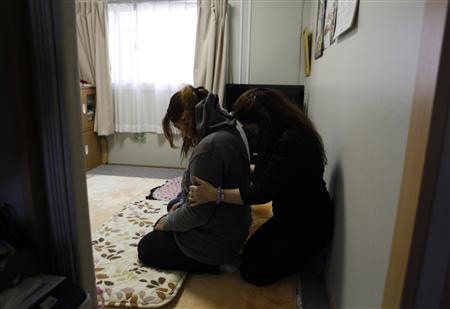當前位置: Language Tips> 雙語新聞
分享到
|
 Fifty-six-year-old exorcist Kansho Aizawa (R) holds a spiritual cleansing ritual for a woman at a temporary house in Higashimatsushima, Miyagi prefecture, February 21, 2013, ahead of the second-year anniversary of the March 11, 2011 earthquake and tsunami. |
|
The tsunami that engulfed northeastern Japan two years ago has left some survivors believing they are seeing ghosts. In a society wary of admitting to mental problems, many are turning to exorcists for help. Tales of spectral figures lined up at shops where now there is only rubble are what psychiatrists say is a reaction to fear after the March 11, 2011, disaster in which nearly 19,000 people were killed. "The places where people say they see ghosts are largely those areas completely swept away by the tsunami," said Keizo Hara, a psychiatrist in the city of Ishinomaki, one of the areas worst-hit by the waves touched off by an offshore earthquake. "We think phenomena like ghost sightings are perhaps a mental projection of the terror and worries associated with those places." Hara said post-traumatic stress disorder (PTSD) might only now be emerging in many people, and the country could be facing a wave of stress-related problems. Shinichi Yamada escaped the waves that destroyed his home and later salvaged two Buddhist statues from the wreckage. But when he brought them back to the temporary housing where he lived, he said strange things began to happen. His two children suddenly got sick and an inexplicable chill seemed to follow the family through the house, he said. "A couple of times when I was lying in bed, I felt something walking across me, stepping across my chest," Yamada told Reuters. Many people in Japan hold on to ancient superstitions despite its ultra-modern image. Yamada, like many other people in the area, turned to exorcist Kansho Aizawa for help. Aizawa, 56, dressed in a black sweater and trousers and with dangling pearl earrings, said in an interview in her home that she had seen numerous ghosts. "There are headless ghosts, and some missing hands or legs. Others are completely cut in half," she said. "People were killed in so many different ways during the disaster and they were left like that in limbo. So it takes a heavy toll on us, we see them as they were when they died." In some places destroyed by the tsunami, people have reported seeing ghostly apparitions queuing outside supermarkets which are now only rubble. Taxi drivers said they avoided the worst-hit districts for fear of picking up phantom passengers. (Source: Reuters)
|
在兩年前發(fā)生那場席卷日本東北部的海嘯后,現在一些幸存者認為自己能看到鬼魂。 在日本社會,人們一般都不愿承認自己有心理問題,因此許多人向驅鬼師尋求幫助。 民間謠傳,有幽靈在原來是商店、如今只剩下一堆瓦礫的地方排隊。精神病醫(yī)生認為這種鬼故事是人們的災后恐懼反應。2011年3月11日發(fā)生的那場大災難,讓近1.9萬人喪生。 石卷市精神科醫(yī)師原敬三說:“人們聲稱見到鬼魂的地方大多是完全被海嘯沖毀的地方。”石卷市是日本那次近海地震所引發(fā)海嘯的重災區(qū)之一。 “我們認為像見鬼等現象,也許是對人們關于受災區(qū)的恐懼和憂慮的一種心理折射。” 原敬三稱,創(chuàng)傷后壓力心理障礙癥也許如今才在很多人身上出現,但日本可能將面臨一波由壓力導致的問題。 山田真一從摧毀居所的海嘯中逃出,后來在廢墟中搶救出兩尊佛像。但據山田說,當他把佛像帶回自己的臨時住房時,怪事開始接連發(fā)生了。 他說他的兩個孩子突然生病了,而且屋內似乎有一股莫名的寒氣一直尾隨著他的家人。 山田告訴路透社記者說:“好幾次我躺在床上的時候,感到有東西穿過我的身體,踩透我的胸膛。” 盡管日本擁有超現代化的形象,但許多日本人依然迷信古老的東西。 跟這一地區(qū)的許多其他人一樣,山田也向驅魔師相澤觀章尋求幫助。 56歲的相澤身穿黑色毛衣和長褲,戴著珍珠耳墜。在她家采訪時,她說自己看到過很多鬼。 “有無頭鬼,有的沒手或沒腳。還有的身體被削掉了一半。”她說,“災難中人們以許多不同的方式喪命,他們在地獄的邊緣仍是這種形態(tài)。所以這對活人的心理造成了重創(chuàng),我們看到的是他們死時的樣子。” 在遭到海嘯破壞的一些地區(qū),有民眾報告說看到鬼魂在已經變成廢墟的超市外面排隊。計程車司機說,他們避免把車開到重災區(qū),因為害怕載到幽靈乘客。 相關閱讀 (中國日報網英語點津 實習生徐凌晨 編輯:陳丹妮) |
|
Vocabulary: exorcist: 驅魔的人;召魂者 limbo: 地獄的邊境 |
上一篇 : 2013兩會代表精彩語錄之五(雙語)
下一篇 : 研究:寶寶反復讀同一本書學得更快
分享到
電話:8610-84883645
傳真:8610-84883500
Email: languagetips@chinadaily.com.cn